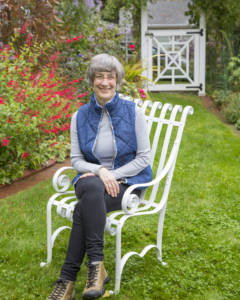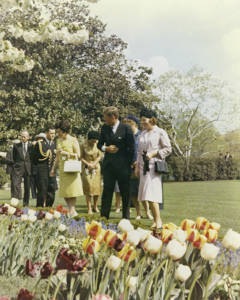
All The Presidents’ Gardens: How The White House Grounds Have Grown with America
On this July 4th holiday, the White House gardens hold a special place. Our presidents and their families have shaped the grounds to reflect their values and the prevailing cultural traditions. In fact, the 18-acres that surround the White House have been re-created time and again over the centuries, beginning with George Washington.
In her captivating new book, All the Presidents’ Gardens, garden historian Marta McDowell traces Madison’s cabbages to Kennedy’s roses and explores how the White House grounds have grown with America.
McDowell’s exploration of how the White House gardens have evolved under different administrations is both timely and refreshing: in this highly-politicized presidential election year, her book avoids partisan politics entirely. Instead, McDowell concentrates on fascinating stories and revealing observations of the White House Garden through the ages. As McDowell puts it, “whether gardeners lean right or left, blue or red, we are united by a love of green-growing things and the land in which they grow.”
The Founding Gardeners
McDowell describes George Washington as a bit “plant-crazy, like most serious gardeners,” and someone who really “enjoyed visiting nurseries.” For his own garden at Mt. Vernon, she writes, “[Washington] planted so many roses that it took twelve days each June for the petals to be picked…”. She also points out that Martha “distilled the petals into rosewater.”
Sadly, Washington died before he could see the results of his classical ideas for the White House garden– ideas that were realized in part by one of his successors, Thomas Jefferson, whom McDowell calls “America’s patron saint of gardening”– not for what he did at the White House, but because of his famous Monticello gardens.
“During the Civil War, the two youngest Lincoln boys, Willie and Tad (the first children to live in the White House) had free run of the country-style garden grounds– as did their pet goats, who relished eating and demolishing loads of flowers in the process.”
Jefferson was known for his views on limited government, so during his presidency he could not be extravagant in his plans and plantings for the White House. He dramatically reduced the garden area by 70-acres from the original “palace-like plans” conceived by L’Enfant, the architect Washington had hired.
But Jefferson did fill the White House window sills with flowering plants like geraniums, new to American horticulture in the 1700s. Originally from South Africa, they arrived in America via Britain. Along with his pet mockingbird named Dick– the first in a prestigious line of pets in the White House and gardens– the geraniums cheered Jefferson up, reports McDowell, as did his studies of fruits and vegetables, which he loved and grew in extensive gardens at Monticello.
Secrets of the White House Gardens
Some little-known stories about the White House gardens include one about President Madison’s Savoy cabbages, which were grown from special seeds provided by the Shaker community near Albany. At the time, the Shakers had already invented the standard paper seed packet that we use today, as they created an innovative seed distribution system in the early 1800s.
Then there’s the story of President Lincoln’s goats. During the Civil War, the two youngest Lincoln boys, Willie and Tad (the first children to live in the White House) had free run of the country-style garden grounds, as did their pet goats, who relished eating and demolishing loads of flowers on the grounds in the process.
During the Wilson presidency, when American entered World War I, the White House’s gardeners were diverted to defense work. McDowell writes: “By the spring of 1918, a herd of twenty Hampshire sheep took up residence on the South Lawn of the White House to keep the grass closely-cropped.” (The sheep actually did double duty, as their wool was auctioned to benefit the American Red Cross.)
When Camelot arrived at the White House in January 1961, one of the few secrets the Kennedy’s kept hidden was the lawn crisis. “It is driving the President crazy,” wrote Jacqueline Kennedy. Before important guests would arrive, The National Park Service gardeners who were responsible for the grounds tried everything, even spray-painting the lawn’s brown patches green, according to McDowell.
Kennedy eventually hired Rachel Lambert Mellon, a family friend, as his horticulturist and garden designer. At Kennedy’s request, Mellon redesigned the Rose Garden to include a variety of plants, not just roses, but tulips, crabapples, and many more. McDowell notes that Kennedy read Jefferson’s garden notes and wanted the new garden to reflect Jefferson’s choices.
In April 1963, just a few months before his death, Kennedy proudly walked through the new Rose Garden with Princess Beatrix of the Netherlands. The main beds were “anchored” by roses, which later (by President Reagan’s proclamation,) became the official national flower of the United States. According to Mellon, roses are “the one flower that unites all the occupants through the history of the White House.”
First Children’s Gardens
Caroline Kennedy had a pretty fancy tree house while she lived at the White House: reportedly it had a staircase, a handrail and a slide. Mrs. Kennedy also asked Rachel Mellon to design a small croquet court for Caroline, then age four, and her younger brother, John Junior. Mellon came up with the idea of a shady fragrant spot where one could sit and read, watching the children, with a shallow pool and “children’s flowers to pick as children do, taking the heads without the stems; Marigolds, nasturtiums pansies, and Queen Anne’s lace.” A statue of a young girl holding a watering can and trowel, made by sculptor Sylvia Shaw, watched over this spot, which later became part of the Jacqueline Kennedy Garden.
In April 1963, just a few months before his death, Kennedy proudly walked through the new Rose Garden with Princess Beatrix of the Netherlands. According to Mellon, roses are “the one flower that unites all the occupants through the history of the White House.”
During the Johnson years, Lady Bird Johnson created a very private Children’s Garden, in addition to her many beautification projects. Her Children’s Garden was sort of hidden away from the public, says McDowell, with a goldfish pond and a Winesap apple tree for climbing. Johnson wrote: “I think of the spot as the sort of place a First Lady who is a grandmother might wheel a baby carriage and sit in the shade and enjoy her backyard, in a quite secluded spot.”
A decade later, President Carter created a platform tree house in a huge blue atlas cedar on the South Lawn where his daughter Amy could have sleepovers with her friends. A revealing archival photograph shows a relaxed Carter playing with his grandson Jason and his daughter, who are climbing the huge tree.
A Favorite Spot
In a recent interview, McDowell spoke about her favorite gardens at the White House, based on her own visits. One standout: the Obama Kitchen Garden and adjacent pollinator garden “– especially because of its connections to Thomas Jefferson and schoolchildren,” she claimed.
Today, the Obama garden has more than 50 varieties of vegetables and the most gorgeous plant labels created by seasoned White House calligraphers. McDowell says that a White House assistant chef traveled to Jefferson’s Monticello in 2009 to get seeds and plants that Jefferson grew in his own garden, which were then planted in Michelle Obama’s edible garden. By so doing, the Obama’s Kitchen Garden– like those of James Madison and Abraham Lincoln– continues the tradition of bringing local food to the president’s table– an idyllic vision for the leader of a nation that deserves liberty and produce for all.






































